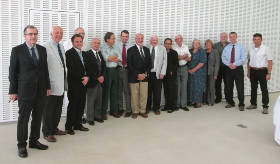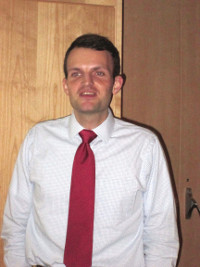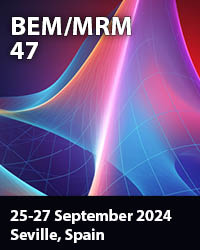
Prof. Jerry J Connor
A special event was recently held at MIT to pay tribute to the many achievements of Professor Jerry J. Connor of the Civil Engineering Department on the occasion of his retirement.
Jerry's career is closely associated with the development of MIT as the foremost School of Engineering in the world. His achievements are many in terms of research and teaching, and he was an outstanding mentor to several generations of engineers, who are now in positions of responsibility in academia and industry all over the world.
The meeting at MIT consisted of a series of papers presented by colleagues, collaborators and past students, demonstrating the influence of Jerry's work, and a number of personal reminiscences delivered by his close collaborators.
The event was opened by Prof Carlos A Brebbia, Director of Wessex Institute of Technology in the UK, who recalled how he was introduced to Jerry as the best person at MIT to supervise his doctoral thesis. At that time Jerry was interested in a new type of engineering science, which was to be called computational mechanics. Carlos' research was on the solution of curved shell problems using finite elements. The result of their collaboration gave rise to Carlos' first two Journal publications, which set the basis for his career as an engineering scientist. The other supervisor of Carlos' thesis at the time was the late Prof Hugh Tottenham and the collaboration gave rise to a long and fruitful association between Jerry and Southampton University in the UK, where Prof Tottenham was teaching.
Jerry's influence – Carlos said – was decisive for his career and his own research work acquired clarity and improved quality through his association with Jerry. His support, Carlos explained, went beyond academic matters, as he became a major influence in his family life. Carlos also benefitted from trying to emulate – not always successfully – Jerry's calm approach to all problems, whether scientific or personal, his impeccable gentleman's behaviour and his total honesty, unable to speak badly of anybody. On many occasions Carlos valued Jerry's unshakeable support in personal as well as professional matters.
Carlos' own idea of Boundary Elements was deeply influenced by Jerry's work on mixed principles which were related to the variational concepts of Eric Reissner, his original mentor at MIT. It took some time after leaving MIT for him to appreciate the importance of Jerry's ideas and it was then that he combined the advantages of finite elements in the form of surface elements only with mixed principles and the use of classical Green's type functions. This was very much a consequence of Jerry's originality and clarity of thought. The fact that Jerry liked the idea was the high point of Carlos' engineering research career, the proof that he needed to start developing what has become a very successful engineering tool. He knows he owes him a great deal.

Some of the participants
The idea of Boundary Elements was substantially different from Carlos' original topic of research on Shell Analysis, and he would not have been able to arrive to it without Jerry's mentoring.
Jerry's contribution to the founding and development of Wessex Institute was crucial for WIT to grow into a renowned institution with its own Campus. His support was always there – even during the initial and difficult times – and Jerry continues to serve as a member of the WIT Board of Directors. This is where his input is most valuable, as he proposes new ideas and strategies and advanced lines of research. Jerry has the unique ability to predict evolving trends and directions for research when they are not yet evident to most other scientists.
Jerry – Carlos said – has been an outstanding teacher as well as an original researcher. His professional work has allowed him to put into practice some of his ideas in major consulting engineering work.
He is author of a series of engineering books, as well as editor of many others. His activities in terms of novel engineering science ideas have been many, including some unique contributions on tall buildings and forensic analysis of major structural failures.
Carlos concluded by saying that it is as a teacher and mentor of several generations of engineering students that Jerry dedicated his full potential. His research gave rise to many groups around the world.

Prof. Connor and Prof. Brebbia
Carlos then presented Jerry with an antique map of Massachusetts, including a plan of Boston, dating back to before the Civil War, saying he hoped this would serve as a reminder of the occasion and a token of appreciation from all the participants.
The next speaker, Prof Jose Roesset from Texas A&M, and formerly of MIT, remembered the time when Jerry started to teach at MIT. Jerry's teaching at the time brought a breath of fresh air to the Civil Engineering Department, contrasting the clarity and simplicity of his lectures with the prevalent complexity of other lessons. Jerry always managed to sort out the most complicated problems, reducing them to the fundamentals and applying simple concepts. Jose was then particularly impressed by the way in which Jerry was able to explain nonlinear buckling problems in a new light.
He also referred to the many changes taking place at MIT at that time and how they influenced Jerry's life and outlook. MIT became a magnet for many researchers and students from all over the world and Jerry participated in a special programme aimed at attracting
Jose thought that this influx – which included Carlos – was decisive in convincing Jerry that there was a world worth seeing beyond the boundaries of Massachusetts. From then on Jerry became an international traveller, visiting a wide variety of countries and spending, along with his wife Barbara, and their six children, a valuable sabbatical at Southampton University, invited by Carlos.
"Jerry is foremost a teacher and a true scholar", said Roesset. In spite of his many publications and his international reputation, his main concern has been with quality, unconcerned with the current trends in measuring research in terms of impact factors and other metrics. He contributed also to the production of outstanding books as a result of his teaching, all of them excelling in clarity.
The next to pay tribute to Jerry was Dr Mauricio Sarrazin, Head of his own Consulting Engineering firm and Professor at the University of Chile. He referred to the importance of Jerry Connor in the development of his own career from the time he started work on his PhD thesis at MIT.

Prof. Petros Komodromos
Mauricio then gave a short technical presentation on the solution of nonlinear Equilibrium problems, a line of research he is now pursuing and one that has also been influenced by Jerry Connor.
Prof Petros Komodromos from the University of Cyprus expressed his appreciation to Jerry for his support during his PhD studies and his consequent research. He delivered a paper on the Response of Seismically Isolated Buildings, a problem of great importance in Cyprus, as well as many other parts of the world.
(Komodromos' work has been published in book form by WIT Press under the title "Seismic Isolation for Earthquake Resistant Structures".)
Prof Ove Gudmestad from the University of Stavanger, Norway commented on the importance of Jerry Connor's career for his own research. The quality of his teaching and Jerry's advice convinced him to work on the then new and exciting field of Offshore Structures. Some of these courses were on Boundary Elements, a technique that indirectly introduced him to the work of Carlos Brebbia.

Prof. Ove Gudmestad
Ove wrote the bulk of his PhD thesis when at MIT, mentored by Jerry, before returning to his native Norway where it was submitted. After that Ove started working for Statoil and invited Jerry to Norway to see some of the many offshore platform projects taking place there.
As a product of his collaboration with Jerry, he continued to work with dynamic response of steel framed structures, and new models were developed to account for the hydrodynamic forces. This research progressed to cover earthquake effects.
Other new topics of Ove's research that were influenced by Jerry include the development of arctic engineering and how to build oil and gas facilities on ice.
Ove's work continued to evolve as a result of the collaboration with Jerry, to include the study of concrete structures and the effects of soil foundations on their structural response.
Jerry also impressed on Ove the need to carry out research work thoroughly, the need to work as a team with your colleagues and to have a critical approach to management. Ove ended by acknowledging his deep debt to Jerry.
(Part of this work has been published in book form by WIT Press under the title "Petroleum Resources", authored by Ove Gudmestad et al.)

Prof. Pierre Ghisbain
Prof Pierre Ghisbain, now at MIT, completed his PhD thesis under Jerry on the topic of Damage Engineering. The idea behind the research is that over the life of a structure, smaller but more frequent earthquakes contribute more to the cumulative damage than the larger earthquakes, on which structural damage is traditionally based. He presents the argument in favour of designing structures beyond what the codes require for their safety.
Pierre proposed a new design method as a result of Jerry's mentoring, involving combining probabilistic principles with traditional structural analysis. The result is an estimate of damage. The case studies presented by Pierre support a drift towards more resilient structures designed to mitigate structural and non-structural damage beyond the traditional life-safety requirements.
Pierre ended his presentation by thanking Jerry for his support and encouragement during his research. (WIT Press has published a book version on this research entitled "Damage-Based Earthquake Engineering".)

Prof. John Niedzwecki
Prof John Niedzwecki from Texas A&M reflected on his arrival at MIT to work with Jerry on a topic related to Artificial Intelligence. It was at a time when Intelligent Systems gave room to Intelligent Design of Knowledge Based Systems dealing with Structural Analysis and Design, amongst others. This resulted in John meeting Ove Gudmestad in Norway and learning the importance of practical knowledge, a constant precept of Jerry's, who has always emphasised the need to solve real engineering problems.
John said that Jerry had a tremendous impact on his career when he started to work on offshore structures. This led more recently to establishing a strategy for sensor placements which was the topic of John's technical presentation.
John is grateful for the advice that he received from Jerry, including not to worry if somebody today takes your idea; ideas will keep coming to you and you will be able to provide better ones in the future. John ended by thanking Jerry for being a great friend, a mentor and an example to emulate.

Prof. Herbert Einstein
Prof Herbert Einstein, of the Department of Civil Engineering at MIT, referred to the important work that Jerry did for the Department.
"Thanks, Carlos, for giving me the opportunity to say a few words and I really will be very short. What I want to do is express my gratitude. On a personal level, I would not have been tenured if it had not been for Jerry's effort. Much more importantly, the department and the profession owes him much. Jerry was, and I have to emphasize, is always ahead of what needs to be solved. He is a committed innovator. He brought materials research and education into the department when it was considered irrelevant. He initiated design education discussions with colleagues in architecture that led to the major revisions and reforming of our education. He took the lead in using artificial intelligence in civil engineering. We all know what a gifted teacher he is, and I think he produced more new courses than all of us together. An example is the steel bridge course - When the students wanted to do this who did they go to? Jerry. We also know of the major role he played in the Master of Engineering program. Both are very typical of the professional relevance of what he is teaching.
This brings me to an interesting and final word: In discussions with Jerry he always said that he is an analyst and he is certainly brilliant in this area. But if we look at the impact it is in engineering, and I would like to end with what I consider of greatest importance: Jerry is an engineer's engineer!!"

Prof. Simon Laflamme
The next speaker was Prof Simon Laflamme, now at Iowa State University, who referred to the importance of Jerry's influence on his life.
Jerry always interacted well with the students, and one of the highlights of this interaction was the organisation of the Master of Engineering Programme, which included at the end, a trip abroad to places of general interest as well as to visit outstanding engineering works. During these trips, Jerry was like one of the students, always enthusiastic and alert.
"Jerry was always updating his courses, teaching in his unique way, which demonstrated his gift as a communicator", Simon said. His input has had an impact on generations of students, changing Simon's life and imparting a love for research.
Prof Oral Buyukozturk from MIT mentioned that when coming to the Department of Civil Engineering, he understood Jerry to be a "finite element" man. Nothing was further from the truth as he showed himself to be fully acquainted with the whole engineering field.
Oral acknowledged his debt to Jerry as an outstanding mentor and thesis advisor.
Dr Hayat Tazir, from T Y Lin Consulting in San Francisco, told of her first encounter with Jerry and how much she enjoyed his way of teaching and lecturing. Coming from Algeria to the new environment of MIT, the thing she appreciated most was the way in which Jerry helped her to settle.
Hayat referred to having had many instructors during her academic years, but Jerry was the most outstanding teacher of them all.
Carlos then read an email sent by John Williams from MIT who could not attend the event. John stated that "In over 20 years I have never heard Jerry say an unkind word or do anything that was destructive or mean" and "Jerry has always been able to see trends far in advance of most of us. He saw concepts such as the Smart City become a reality.
John concluded "It is true to say that Jerry's retirement marks the passing of an era".

Prof. Dick Dippery
Prof Dick Dippery from Kettering University, referred to the influence Jerry had on him through his work on Boundary Elements with Carlos, from whom he became aware of Jerry's contribution in the field.
Dick considers himself more an engineer than an academic. His interest in theoretical mechanics started with the need to solve real engineering problems. He decided to learn Boundary Elements and in this way became aware of Jerry's work, after appreciating the beauty and simplicity of the method and its important applications in practice.
He was also aware of Jerry's name in the field of offshore structures and when he met him, also started to appreciate his qualities as a teacher. Furthermore, he thought that Jerry's books were perfectly structured, showing first the theory and progressing towards the practical applications, with the solid basis of a well understood theory.
After these remarks, Carlos asked Jerry to comment and share his ideas with the audience.
Jerry referred to his nearly 60 years of study and service at MIT, an unusual place in which one is surrounded by very clever people. The secret of his continuous success has been to listen and respect all of his colleagues and students. His kind personality and generous hospitality will be remembered by many, with gratitude.
He started his research career at the best possible time, when the emergence of finite elements and computer processes generated the new research field of computational mechanics. The first generation of computer codes such as STRUDL developed at the Civil Engineering Department of MIT were to set the guidelines for the rapid expanse of FEM tools. Jerry contributed to this in the field of Structural Mechanics before turning his attention with Carlos to the new topic of Computational Fluid Mechanics. This collaboration resulted in two FEM books, one on structures and the other on Fluid Mechanics.

Prof. Jerry Connor
Jerry was later attracted to the possibility of Artificial Intelligence (AI) and how to apply it in practice. The idea has somewhat returned with the recent emergence of Intelligent Engineering. At that time however, AI died out rather quickly and he was to return to more classical structural research.
Different interests came together in the setting up of the Master of Engineering programme, which continued for 20 years, producing 20 graduates per annum. This gave rise to a network of very successful graduates, now in positions of responsibility in academia and industry. The programme has now unfortunately ceased.
A lifetime's work was condensed into Jerry's book on "Fundamentals of Structural Engineering". It starts with basic concepts and builds up to the use of structural software. Its idea is to prepare the reader for the challenges of a modern world.
He remains interested in changing the way in which structural design is taught, focusing on motion rather than strength. This is a topic closely related to future changes which require resilient design to withstand extreme events, including those related to climate change.
Jerry concluded his remarks by stressing the need to be kind to each other, particularly to young people. Students – he said – should be treated as equals, installing in them the confidence that they will require in their future professional lives.
The participants were invited to a banquet organised by Jerry in a downtown restaurant during which they relaxed in a friendly and convivial atmosphere, further remembering their time at MIT working with Jerry.

Participants at the banquet




